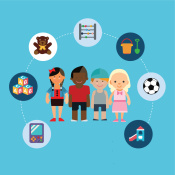Critical Information
The number of children ages 3 to 17 struggling with anxiety or depression rose by 1.5 million between 2016 and 2020. Educators trained in resilience will fortify their students and raise their potential for learning.
Two modes for promoting student resilience
Synchronous solutions…
include facilitated small group discussion, coaching, workshops, and more. Our unique web events include live group therapy, humor workshops to infuse fun into the classroom and even live events with comedians. Enjoy the video example.
Asynchronous solutions…
include on-demand video engagements on a range of topics from autism to dealing with difficult students. Faculty (and parents) can learn the rubric for developing greater resilience, will pass along this learning to students. Please enjoy this video montage on student engagement from our on-demand video library.
On-demand virtual engagements

Autism Part I
You can’t afford to leave anything to chance when students on the spectrum are in your classroom. Find out why a little fact-finding will make all the difference for them… and for you, too.

Autism Part II
There’s no such thing as a typical day for atypical students. Find out how to make the day as predictable as possible, giving your students on the autism spectrum indispensable structure.

Autism Part III
Students on the autism spectrum can be your absolute best rule-followers. If your students are off-task or breaking rules, find out here how you can flip that around.

Autism Part IV
Don’t be in the dark about one of the most intense triggers affecting students on the spectrum. This engagement shines the spotlight on sensory challenges and provides sensational strategies.

Autism Part V
Facing something new is extremely anxiety-provoking to students on the autism spectrum. Learn how to take the anxiety out of new experiences, so that every new adventure is smooth sailing.

Autism Part VI
An inclusive classroom takes effort from all members. Learn how to bolster both students on the spectrum and their typical peers as you construct a cohesive community of empathic supporters.

Autism Part VII
Even once your students’ bodies are comfortably settled in your classroom, their minds may still be far away. Learn to use the “hook” to get and keep your students engaged in the curriculum.

Autism Part VIII
Eager to learn how to handle difficult behaviors? Don’t jump ahead! Most of the answers you need are in all the segments in this series that come before this one! This brings it all together.
Success Stories

"Whole School Health Through Psychosocial Emotional Learning highlights the importance of relationships, communication, and compassion for others. It presents a critical view in supporting, training, and retaining teachers through the lens of engaging and modeling behaviors that will help our rural students be better civic leaders and community members. My favorite quote from the book gives credit to the author's upbringing and modeling from his parents: 'We must experience the world through others so we can fully engage in educating all children. My father and mother modeled to me and my siblings how to experience the world through somebody else’s eyes, especially if their outer differences stirred up discomfort or displeasure, enriching all lives involved.' I recommend all leaders, teachers, and stakeholders secure their copy as they prepare for school."
Allen Pratt, Executive Director, National Rural Education Association (NREA)